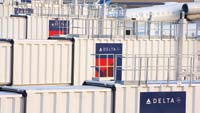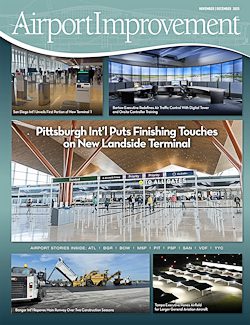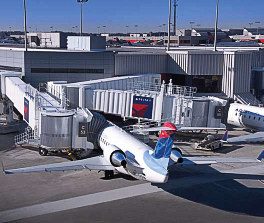
As the busiest passenger airport in the world, Atlanta Hartsfield-Jackson International (ATL) is a fast-paced environment. And Delta Air Lines is keeping right in step as it wraps up a $26 million concourse revamp in less than two years.
Under a design-build contract with The AERO Group, the 90,000-square-foot Concourse C is being converted from a facility that was originally designed for 13 narrow-body aircraft to one that will accommodate 26 regional jets. Completion is expected in April – fully five months ahead of schedule.
Concourse C previously included gate positions that were all serviced from ramp-level stairwells. This setup required passengers to go down stairs and walk out on the ramp to board the aircraft – far from ideal, according to Jaco Claassens, senior project manager with Delta Air Lines. “Passengers now have a better experience going through Concourse C,” he says.
|
Atlanta Hartsfield-Jackson |
ATL’s Rob Rau, senior planning manager of airfield and airspace, agrees. “It’s definitely an enhancement,” says Rau. “Any time you can get the passengers off the ramp, that’s a good thing.” He also considers it a prime example of the airport’s needs matching with the airline’s needs.
Before the reconfiguration, aircraft parked at the gates were sometimes blocked from getting out. The new design, notes Claassens, prevents that from happening. “It’s just a better operation, a better experience, a better product,” he says.
|
Facts & Figures Project: Airside Concourse Reconfiguration Location: Atlanta Hartsfield-Jackson International In Brief: Delta is converting airside facilities for 13 narrow-body aircraft to accommodate 26 regional jet aircraft Cost: $26 million Engineering/Design: AERO Systems Engineering Construction & Equipment Installation: AERO BridgeWorks Boarding Bridges: JBT AeroTech Completion: Slated for April Project Scope: Design/planning/construction of electrical and mechanical infrastructure upgrades, emergency egress, vehicle service road and tug road layouts, terminal building doors, security access control systems, aircraft parking, passenger boarding bridges, walkways, structural foundations, preconditioned air, 400Hz and 28.5VDC ground power systems, baggage valets and aircraft fueling. |
No Break in the Action
Keeping the concourse completely operational throughout the reconfiguration was a major challenge throughout the project. Work on the concourse was completed in phases to ensure that at least 23 gates were available, even under the worst-case scenario. All 26 gates were available during busier periods, including the Christmas and Thanksgiving holidays, specifies Claassens.
“We had to work closely with Delta to reroute passenger traffic,” notes C. Alan Barge, P.E., president of AERO Systems Engineering. “Passenger access had to be studied for each phase.” In addition, hold room space, non-licensed vehicle roads and tug traffic were closely analyzed from phase to phase to ensure minimal disruption to airport operations and to preserve the proper passenger experience.
“We need to perform the project without impacting ongoing operations for all flights,” stresses Claassens. “None of what we do can impact flight schedules at the busiest airport in the world.”
According to Barge, careful planning not only prevented loss of aircraft parking positions, it also provided for future growth regarding other aircraft models and facilitated flexible operations with mainline aircraft.
Concourse C can now be configured to accommodate eight 737s – something that was previously impossible. “Now we can park anything from a 50-seater to a 737 and it has been constructed for that use,” says Claassens.
Flexibility is important for the airline to get the most use out of the facility and provide the best passenger experience, he notes. “It also helps us to provide network flexibility to schedule our future flights,” he adds.
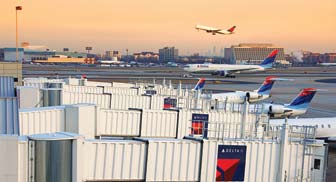 Work on the fuel system also required careful choreography during the project. The hot tap – when crews tap into the active fuel system – was performed at night and coordinated not just with Delta, but also with the entire airport because it required the fuel system for the entire airport to be shut down.
Work on the fuel system also required careful choreography during the project. The hot tap – when crews tap into the active fuel system – was performed at night and coordinated not just with Delta, but also with the entire airport because it required the fuel system for the entire airport to be shut down.
According to Rau, the new configuration will improve airfield safety. Because aircraft at Concourse C can now be fueled through the airport’s hydrant system, there will be fewer fuel trucks driving airside.
Tricks of the Trade
To ensure smooth operations and timely delivery of equipment and materials, the AERO Group provided its own construction escorts. A dedicated fleet escort trucks and drivers were on hand 24/7 to help expedite the arrival of concrete trucks and other time-sensitive elements. “This prevented us from being dependent on third-party or airport escort vehicles, thereby ensuring the timely delivery of all equipment and materials to maintain workcrews were properly supplied and coordinated,” notes Barge.
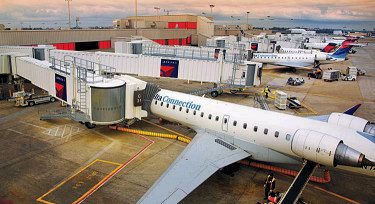 Providing all of its own equipment per the design-build contract was another time saver, says Barge. “Our purchasing power with the manufacturers allowed us to leverage the best price possible,” he explains. “Also, as we are involved in many projects all over the country, we worked closely with the manufacturers to manipulate slots between several ongoing AERO projects to ensure the on-time or accelerated, as needed, delivery of equipment for this project.”
Providing all of its own equipment per the design-build contract was another time saver, says Barge. “Our purchasing power with the manufacturers allowed us to leverage the best price possible,” he explains. “Also, as we are involved in many projects all over the country, we worked closely with the manufacturers to manipulate slots between several ongoing AERO projects to ensure the on-time or accelerated, as needed, delivery of equipment for this project.”
Material selection by the firm that specializes solely on aviation fixed ground support systems also helped maintain the fast-paced project schedule. Concrete with high early strengths, for instance, was used on all foundations and ramp back pours. Keeping cure times to a minimum allowed maximum flexibility for the installation of the passenger boarding bridges and other equipment, and allowed the ramp surfaces to be returned to service as quickly as possible. Pouring schedules were also coordinated so other jobs could be conducted during the cure times.
Barge says it is that type of planning, attention to the schedule and careful coordination with the airlines and equipment manufacturers that will allow the project to be completed in April, five months ahead of schedule.
“This was an exciting project for Delta and presented a tremendous improvement to our passenger’s experience on Concourse C,” says John Boatright, Delta Air Lines vice president, Corporate Real Estate and Sourcing Strategy.

